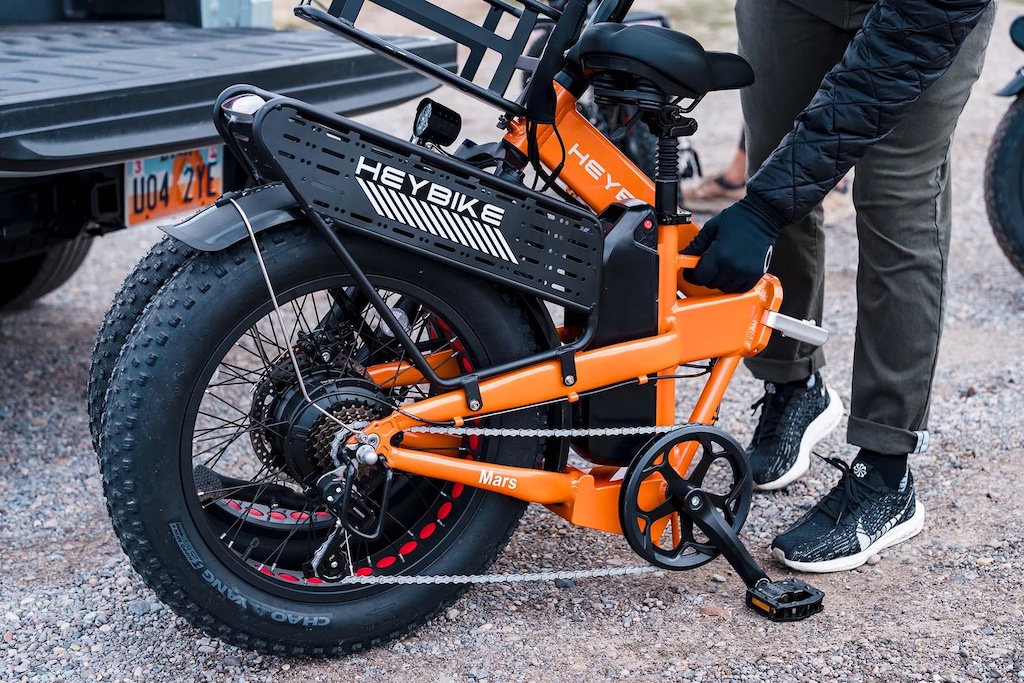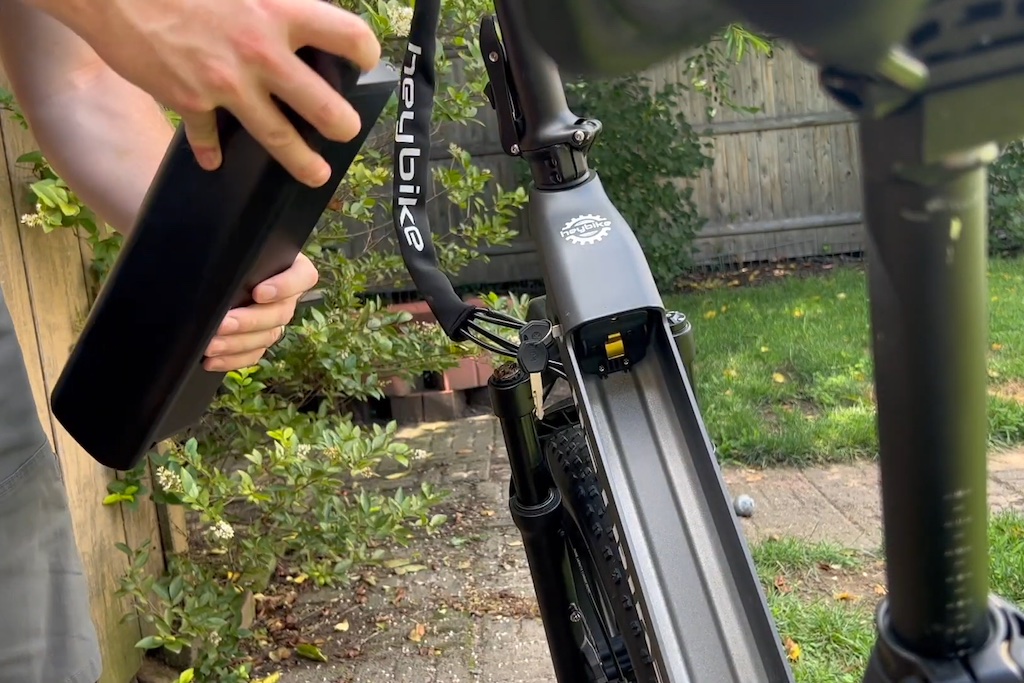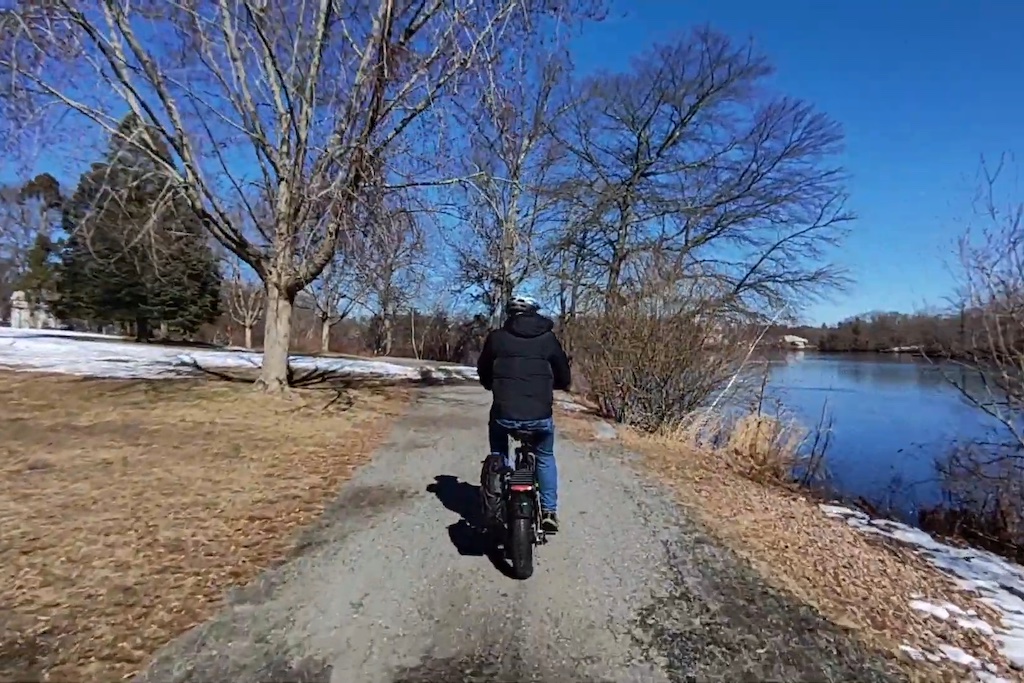Autumn Gear Guide
Find inspiration in our Gear Guide that will keep you out on your bike through wind or rain.
Download NowCrunch! Sizzle! Groan! The street was noisy that morning, as the HeyBike Mars 2.0 rolled over potholes and ice. Clunk! Crackle! Thunk! Hiss! Grind! Swish! Splash! Block by block I bobbed along, navigating the winter-battered city at 32 kph. February weather wreaks havoc on Rhode Island motorways, as frost heaves rip open the asphalt and […]
Crunch! Sizzle! Groan! The street was noisy that morning, as the HeyBike Mars 2.0 rolled over potholes and ice. Clunk! Crackle! Thunk! Hiss! Grind! Swish! Splash! Block by block I bobbed along, navigating the winter-battered city at 32 kph.
February weather wreaks havoc on Rhode Island motorways, as frost heaves rip open the asphalt and road salt mixes with granular snow into an unholy mess. The gutters are so clogged with debris that you can barely see the drains. When the thermometer hovers over zero degrees, snowbanks melt into murky rivers, only to freeze—after dusk—into treacherous black ice.
Yet this is what the Mars 2.0 was built for: hard, hostile terrain. The textured tires are four inches (10.16 centimeters) thick and easily bounce over rocks and branches. The seven-speed cassette and five levels of pedal-assist help the bike navigate complex landscapes, particularly steep hills. The compact design is dextrous in traffic and tight spaces. What’s more, the Mars 2.0 looks tough, with its no-nonsense design and subdued color schemes. The Mars 2.0 is ready for action, whenever and wherever you want to go, even New England in the middle of winter.
It’s also a bargain, at least for the moment. As I write this, the Mars 2.0 is selling for about $1,000 US, a gobsmacking deal for a quality e-bike.

Hey Bike 2.0 folds well and fits in a trunk
HeyBike has mastered the craft of sensible electric bikes, and the Mars 2.0 is among the most adaptable machines you can find. The knobby fat tires can take you over the most temperamental surfaces, cushioned by front suspension. The design is typical for a folding model, with simple, linear geometry and an upright sitting position. Like many such machines, it looks and feels much larger in person than it appears in photos. This machine is like the Geo Tracker of e-bikes: efficient, commanding, and comfortable in urban traffic or on wilderness trails.
I was able to assemble the Mars 2.0 in about an hour, and the bike comes with many thoughtful touches: There’s a built-in horn that is loud enough to hear through car windows. The head- and tail lights are easy to switch on and off, and they’re bright enough for passing drivers to see at night. Basic functions are easy to figure out on the black-and-white interface. The Mars 2.0 is also a Class 3 e-bike, meaning it can reach speeds of 45 kph and has a welcome throttle.

The best part of the Mars 2.0 is its folding mechanism, which allows you to transport the bike in a motor vehicle or easily store it inside an apartment or office. I can’t overstate how handy it is to fold your e-bike in half; 34 kilograms is a lot of weight to push, and a dead battery or flat tire could spell disaster in a remote location.
One of the most eye-catching features of the Mars 2.0 is its luggage rack, which has distinctive side-panels. The aesthetic is industrial, but the panels also add a little more protection for your panniers (or other bags), lessening the chance that they’ll rub against the rims or spokes.
Having reviewed the Ranger S a few months ago, I can’t help but compare the two bikes. The Ranger S is a lot to live up to: It remains one of my favorite e-bikes of 2023, with a sleek design, intuitive features, and a similar all-road capacity. The Mars 2.0 is very similar in many ways, but I personally prefer the Ranger S for several reasons.
First, the Ranger S has a much lower frame, so it qualifies as “step-through,” making it easier to mount and dismount. The Ranger S also stores its battery inside the frame, which is both more attractive and harder to steal. Both models have kill switches, which can disable the battery, but without a key, a stranger can’t access the Ranger S battery, so the kill switch doubles as a security measure.

Removable battery
The two bikes have roughly the same weight, and their 750w motors seem practically identical. The Mars 2.0 folds a little bit smaller, but their sizes and riding configurations are comparable. Their differences are mostly superficial and barely affect how they ride, and their original price tag was identical as well; but at the time of writing, the Ranger S costs about $300 more than the Mars 2.0, which suggests a clearer curb appeal.
My one true struggle with the Mars 2.0 was the interface, which is simple and clear for basic functions but became confusing as I tried to increase the maximum speed from 32 kph to 45 kph. HeyBike has an app, and you can connect the Mars 2.0 to your smartphone, which many riders will find useful and enjoyable, but apps may not win over luddites like myself. In the end, I had to turn to YouTube to help me troubleshoot.
For riders new to pedal-assist, Mars 2.0 may be the ideal introductory e-bike. It’s reasonable for a novice to put together and equipped for many different uses, from grocery trips to commutes to backwoods expeditions. With a weight capacity of 150 kg, this frame can carry a lot of baggage. With a little customization, you could probably take a petit passenger as well.
A folding bike is always handy for dense urban environments, where storage space is often scarce. The folded dimensions are too robust to fit under a desk or inside a bus, but the Mars 2.0 may be discreetly stored in closets, lobbies, or balconies. If you live in an under-funded industrial city like I do, your wheels can never be too durable, and fat tires are a great comfort.

But the Mars 2.0 also looks at home on country roads, and here is where it excels beyond the Ranger S: HeyBike has created an e-bike that could serve well for bikepackers. The company promises a maximum range of 72 km on a single charge, depending on encumbrance and the level of pedal-assist. For outdoorspeople, that distance is a lot of ground to cover, and the rear rack can support a large quantity of camping equipment.
The Ranger S could serve well, but the Mars 2.0 has a bolder feel on singletrack. (Just make sure e-bikes are permitted on the trails you want to ride). No matter what your experience with electric bikes, the Mars 2.0 is a solid, economical choice from a company that has already set high standards.
Find inspiration in our Gear Guide that will keep you out on your bike through wind or rain.
Download Now
Leave a comment